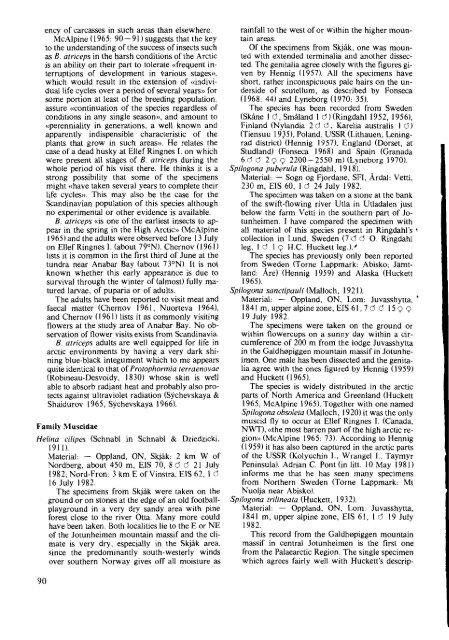Full-text - Norsk entomologisk forening
Full-text - Norsk entomologisk forening
Full-text - Norsk entomologisk forening
- No tags were found...
Create successful ePaper yourself
Turn your PDF publications into a flip-book with our unique Google optimized e-Paper software.
ency of carcasses in such areas than elsewhere.McAlpine (1965: 90- 91) suggests that the keyto the understanding of the success of insects suchas B. atriceps in the harsh conditions of the Arcticis an ability on their part to tolerate «frequent interruptionsof development in various stages",which would result in the extension of «individuallife cycles over a period of several years» forsome portion at least of the breeding population,assure «continuation of the species regardless ofconditions in any single seaSOll)', and amount to«perenniality in generations, a well known andapparently indispensible characteristic of theplants that grow in such areas». He relates thecase of a dead husky at Ellef Ringnes r. on whichwere present all stages of B. atriceps during thewhole period of his visit there. He thinks it is astrong possibility that some of the specimensmight «have taken several years to complete theirlife cycles». This may also be the case for theScandinavian population of this species althoughno experimental or other evidence is available.B. atriceps «is one of the earliest insects to appearin the spring in the High Arctic» (McAlpine1965) and the adults were observed before 13 Julyon Ellef Ringnes I. (about 79°N). Chernov (] 9611lists it is common in the first third of June at thetundra near Anabar Bay (about 73°N). It is notknown whether this early appearance is due tosurvival through the winter of (almost) fully maturedlarvae, of puparia or of adults.The adults have been reported to visit meat andfaecal matter (Chernov 1961, Nuorteva 1964),and Chernov (] 961) lists it as commonly visitingflowers at the study area of Anabar Bay. No observationof flower visits exists from Scandinavia.B. atriceps adults are well equipped for life inarctic environments by having a very dark shiningblue-black integument which to me appearsquite identical to that of Protophormia terraenovae(Robineau-Desvoidy, 1830) whose skin is wellable to absorb radiant heat and probably also protectsagainst ultraviolet radiation (Sychevskaya &Shaidurov 1965, Sychevskaya 1966).Family MuscidaeHelina cilipes (Schnabl in Schnabl & Dziedzicki,1911).Material: - Oppland, ON, Skjiik: 2 km W ofNordberg, about 450 m, EIS 70, 8 0 0 21 July1982; Nord-Fron: 3 km E of Yinstra, EIS 62, I 016 July 1982.The specimens from Skjiik were taken on theground or on stones at the edge of an old footballplaygroundin a very dry sandy area with pineforest close to the river Otta. Many more couldhave been taken. Both localities lie to the E or NEof the Jotunheimen mountain massif and the climateis very dry, especially in the Skjak area.since the predominantly south-westerly windsover southern Norway gives off all moisture asrainfall to the west of or within the higher mountainareas.Of the specimens from Skjiik, one was mountedwith extended terminalia and another dissected.The genitalia agree closely with the figures givenby Hennig ([957). All the specimens haveshort, rather inconspicuous pale hairs on the undersideof scutellum, as described by Fonseca(1968: 44) and Lyneborg (1970: 35).The species has been recorded from Sweden(Skane 10, Smiiland I 0)(RingdahI1952, 1956),Finland (Nylandia 2 cl cl, Karelia australis 1 0)(Tiensuu 19J5), Poland, USSR (Lithauen, Leningraddistrict) (Hennig 1957), England (Dorset, atStudland) (Fonseca 1968) and Spain (Granada6 cl cl 299 2200-2550 m) (Lyneborg 1970).Spi/ogona puberula (Ringdahl, 1918).Material: - Sogn og Fjordane, SFT, Arda1: Yetti,230 m, EIS 60, I cl 24 July 1982.The specimen was taken on a stone at the bankof the swift-flowing river Utla in Utladalen justbelow the farm Yetti in the southern part of Jotunheimen.I have compared the specimen withall material of this species present in Ringdahl's \collection in Lund. Sweden (7 cl cl O. Ringdahlleg, I cl I 9 RC. Huckett leg.)."The species has previously only been reportedfrom Sweden (Torne Lappmark: Abisko; Jamtland:Are) (Hennig 1959) and Alaska (Huckett1965).Spi/ogona sanctipauli (Malloch, 1921).Material: - Oppland, ON, Lom: Juvasshytta, •1841 m, upper alpine zone, EIS 61, 7 0 0 159 919 July 1982.The specimens were taken on the ground orwithin flowercups on a sunny day within a circumferenceof 200 m from the lodge Juvasshyttain the Galdh0piggen mountain massif in Jotunheimen.One male has been dissected and the genitaliaagree with the ones figured by Hennig (1959)and Huckett (] 965).The species is widely distributed in the arcticparts of North America and Greenland (Huckett1965, McAlpine 1965). Together with one namedSpi/ogona obsoleta (Malloch, 1920) it was the onlymuscid fly to occur at Ellef Ringnes I. (Canada,NWT), «the most barren part of the high arctic region»(McAlpine 1965: 73). According to Hennig(] 959) it has also been captured in the arctic partsof the USSR (Kolyuchin I., Wrangel I.. TaymyrPeninsula). Adrian C. Pont Gn litt. 10 May 1981)informs me that he has seen many specimensfrom Northern Sweden (Tome Lappmark: MtNuolja near Abisko).Spilogona trilineata (Huckett, 1932).Material: - Oppland, ON, Lom: Juvasshytta,1841 m, upper alpine zone, EIS 61, 10 19 July1982.This record from the Galdh0piggen mountainmassif in central Jotunheimen is the first onefrom the Palaearctic Region. The single specimenwhich agrees fairly well with Huckett's descrip90

















